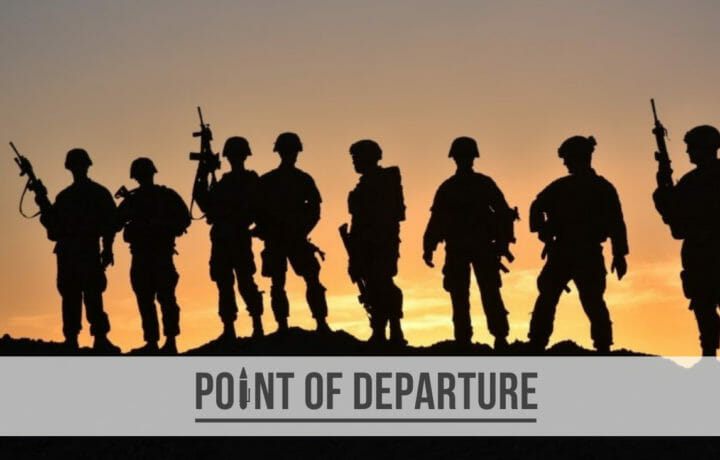“Not all women wear pearls and sensible shoes to work. Some wear dog tags and combat boots.” – Anonymous
During the lead up to a less-than-enthralling battle between Mike Tyson and Jake Paul last week, one preliminary fight stood out for its brutality, ferocity, and grit: the contest that pitted Katie Taylor against Amanda Serrano.
It was a grudge match, pitting two storied fighters in the twilight of their careers against one another one last time. It was an epic battle, a fight for the ages. And, yes, it was two women taking center stage for what quickly became the marquee fight of the night.
Serrano emerged for the fight ready for war. Literally. Flanked by the Dallas Cowboys cheerleaders and sporting a flak vest, she came prepared for battle. And it was a war: a “magnificent but blood-soaked epic” between two of the most storied fighters of their generation. Through ten rounds of intense and often controversial boxing, neither woman backed down, neither woman stopped swinging. When the punches finally stopped flying – with all three judges scoring the fight 95-94 – Taylor narrowly retained her undisputed super lightweight title.
THE Women in Combat DEBATE
In the wake of the fight, online commentary focused on different aspects of the fight – including the vicious head butt that Taylor used to bloody her opponent – but no one questioned their toughness, resilience, or ability. Instead, words like “legend,” “GOAT,” and “champion” ruled the discussion threads. The BBC referred to the match as “a testament to two incredible fighters – two legends of the sport.”
You’d almost forget that it was two women battling it out in the ring.
Contrast that with last week’s ceremony at RAF Lakenheath, during which the crew of an F-15E received the Silver Star – the third-highest military decoration for valor – for “battling a barrage of Iranian missiles and drones” during an attack against Israel earlier this year. Captain Lacie Hester, the weapons systems officer, shared the moment with the pilot, Major Benjamin Coffey. Despite some who called the ceremony a “publicity stunt” and “sycophantic social affirmation therapy,” their mission was as uncommon as it was noteworthy.
“During their first flight, the pair intercepted six drones flying in the dark at low altitude.” Even after experiencing a “hung missile” they continued to engage targets with the F-15’s Gatling gun before eventually returning to base. Upon learning that a replacement F-15 was fueled and ready, the pair returned to the fight in the second aircraft, again firing all available weapons. “Hester also direct fighter jets in the area through the end of the Iranian attack.”
One commentator called it “pathetic,” saying that Hester received the award for just doing her job as a woman. While no one openly questioned Coffey’s award, gender became a central element of many arguments, with Hester’s medal ranging from a nod to DEI to inappropriate for a “broad [who] wasn’t even piloting.” In any number of discussion threads, it was like a bizarre online reunion of “The He-Man Woman Haters Club.”
THe iLLOGICAL ARGUMENT
In short order, the old sexist tropes and worn-out arguments against women serving in combat resurfaced. Perhaps emboldened by recent events, men and women alike thrust their arguments into the spotlight, quickly devolving into a veritable “who’s who in the zoo” of logic fallacies and cognitive biases.
1. Strawman.
“We need to stop pretending that women and men are the same.” No one is suggesting this, but it’s an often-used fallacy to misrepresent the argument to make it easier to attack, typically with another fallacy.
2. False Dilemma.
“The only way women can serve in combat roles is to lower the standards.” This fallacy is often supported by nonsensical anecdotal evidence, but the core argument is the same: there are no other options for women to serve in combat roles: the standards have to be lowered for women to succeed.
3. Appeal to Ignorance.
“I know 1000 men who can do that job better than one woman.” Often paired with the false dilemma, this argument builds on a complete lack of evidence – hence the appeal to ignorance – to justify gender bias.
4. Slippery Slope.
“Women will be a distraction, and discipline and effectiveness will suffer.” Just because you’re distracted doesn’t mean that they are; face it – not every woman wants to sleep with you. Get over it.
5. Appeal to Fear.
“Allowing women to serve in combat roles will lead to increased casualties, or worse.” The appeal to fear typically follows close on the heels of the false dilemma. Because men will be “distracted” by women, they’ll be more focused on protecting them than fighting and, hence, more casualties will ensue. Let’s just forget the fact that most valor awards are earned for protecting others.
Final Arguments
When all else fails, The Ad Hominem attacks enter the ring. “Women are not physically or emotionally capable of serving effectively in long campaigns.” Forget the fact that there are documented examples of this rationale playing out across the genders. Combat affects different people differently; some people are better suited – both physically as well as emotionally – for long deployments than others.
War is a complex and violent endeavor. Frankly, we’re well past the point of concerning ourselves with gender. This is a matter of finding the best talent possible and not limiting ourselves by succumbing to biases. We were fortunate to have Lacie Hester and Ben Coffey in the air that Saturday last April; let’s keep it that way.




